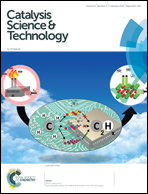Sequential ionic layer adsorption and reaction (SILAR) deposition of Bi4Ti3O12 on TiO2: an enhanced and stable photocatalytic system for water purification†
Abstract
A new method to produce bismuth titanate – titanium dioxide composites by modification of a TiO2 film deposited on a variety of different glass substrates is reported. Using a simple SILAR method, BiOBr may be deposited upon TiO2 surfaces, which upon heating forms a closely intercalated structure of bismuth titanate (Bi4Ti3O12, BTO) and TiO2. This new method expands the scope of the SILAR process, which is typically restricted to materials which can be formed from soluble precursors. This composite material has undergone a thorough materials characterisation to confirm the absence of the BiOBr precursor, and the formation of the new bismuth titanate phase. The electronic structure of the heterojunction formed has also been investigated by valence band XPS and diffuse reflectance measurements, and a plausible band structure proposed. The immobilised composites have then been applied to the photocatalytic degradation of organic pollutants and bactericidal testing, as well as stability tests and identification of the key reactive species. Further photocatalytic studies have been carried out on this material in a synthetic wastewater medium, taking a step towards application under real-world conditions.



 Please wait while we load your content...
Please wait while we load your content...